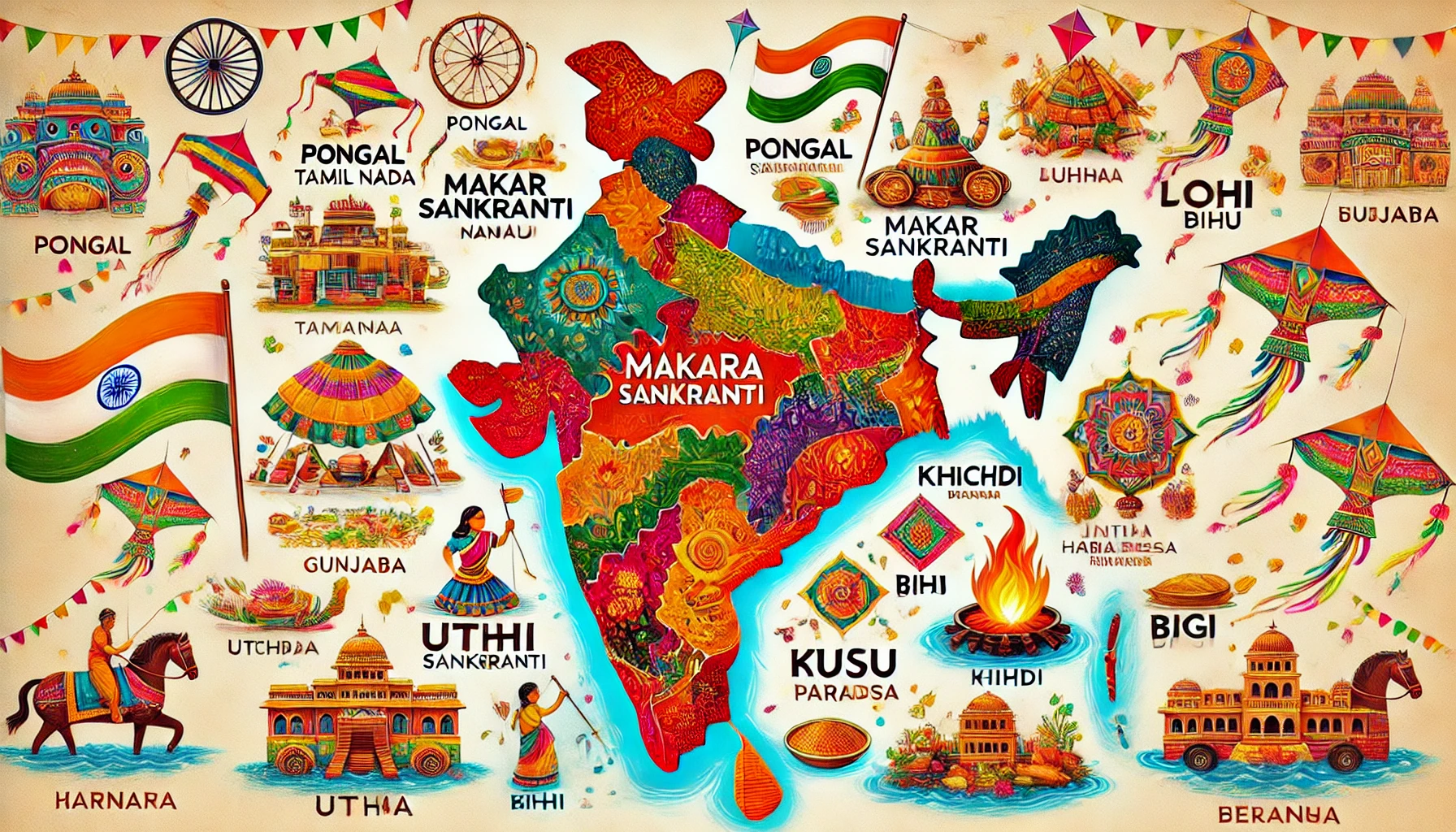Makara Sankranti: A Vibrant Celebration Across India
14, Jan 2025
58
Makara Sankranti: A Vibrant Celebration Across India
Makara Sankranti, a harvest festival, is one of the most widely celebrated occasions in India. Though celebrated across the country, it is known by different names in various states, each adding a unique flavor to this joyous occasion. Celebrated on January 14 every year, Makara Sankranti marks the transition of the Sun into the zodiac sign of Capricorn (Makara), signifying the end of the winter solstice and the beginning of longer days. This festival is not just a time for family gatherings, but it also holds spiritual, cultural, and agricultural significance.
Let’s explore how different states of India celebrate this festival, each with its unique traditions, customs, and names.
1. Pongal (Tamil Nadu)
In Tamil Nadu, Makara Sankranti is known as Pongal. It is the most important festival in the state and is celebrated over four days. The first day is called Bhogi Pongal, when old items are discarded to symbolize a fresh start. The second day, Thai Pongal, is the main day of the festival, when families offer prayers to the Sun God and prepare a special dish called Pongal made with newly harvested rice, jaggery, and milk. The third day is Mattu Pongal, dedicated to honoring cattle, especially bulls, for their role in farming. The final day is Kaanum Pongal, when families reunite, and people go on picnics.
2. Makar Sankranti (Maharashtra)
In Maharashtra, the festival is simply called Makar Sankranti. It is a time to fly kites, as the skies are filled with colorful kites during the day. The special dish made during this festival is tilgul, a sweet made from sesame seeds and jaggery. It is a symbol of goodwill and is exchanged with the phrase "Tilgul ghya, god god bola" (Eat sesame seeds and jaggery and speak sweetly). People also take a holy dip in rivers, especially at places like Nashik and Trimbakeshwar, to purify themselves.
3. Uttarayan (Gujarat)
In Gujarat, Makara Sankranti is known as Uttarayan. This is one of the most famous kite festivals in India. On this day, people gather on rooftops to fly kites and celebrate the triumph of light over darkness. The event is accompanied by music, dance, and the sharing of special sweets like undhiyu (a vegetable dish), doodh-pak (sweet milk pudding), and tilgul. The atmosphere is filled with excitement as people compete in kite flying, and there are often massive celebrations in cities like Ahmedabad and Surat.
4. Lohri (Punjab)
In Punjab, Makara Sankranti is celebrated as Lohri, a festival that marks the end of winter and the arrival of the harvest season. Lohri is celebrated with much fanfare, with people lighting bonfires in their neighborhoods and singing traditional songs. People walk around the bonfire, toss sesame seeds, jaggery, and peanuts into the flames as offerings, and dance the bhangra and gidda. This festival is also associated with the harvest of sugarcane, and the traditional foods of Lohri include makki di roti (cornbread) and sarson da saag (mustard greens).
5. Sankranti (Karnataka)
In Karnataka, Makara Sankranti is celebrated with a variety of customs. Known as Sankranti, it involves visiting family and friends, exchanging sweets made from sesame seeds, jaggery, and sugar, similar to other states. In rural areas, the festival includes yellu-bella (a mixture of sesame seeds, jaggery, and coconut), which is shared with others to symbolize goodwill. Additionally, people take a holy dip in the rivers like the Tungabhadra. There are also folk performances such as Kichchu Haadu (traditional songs) and vibrant processions during Sankranti.
6. Maghi (Haryana and Himachal Pradesh)
In Haryana and Himachal Pradesh, the festival is celebrated as Maghi. It is a day for family gatherings, prayers, and meals. Traditional dishes like kheer (sweet rice pudding) and til-pitha (sesame seed sweets) are made. People also go to the river to bathe and offer prayers. The festival marks the arrival of the harvest season, and communities come together to rejoice in the bountiful crops.
7. Bihu (Assam)
In Assam, the festival is celebrated as Bihu, known as Magh Bihu in this context. It is a festival that marks the end of the harvest season and is celebrated with grand feasts and community dances. The preparations include making pitha (rice cakes), and people engage in games and sports. Bihu dance, with its rhythmic moves and vibrant music, is performed by the youth in traditional attire, adding to the festive spirit.
8. Khichdi (Uttar Pradesh and Bihar)
In Uttar Pradesh and Bihar, the festival is known as Khichdi. The main highlight of the festival is the preparation of khichdi, a dish made of rice and lentils, and offering it to the Sun God for blessings. People also light bonfires and perform religious rituals. In some places, it is considered an auspicious day for fasting and charity.
9. Tusu Parab (West Bengal)
In West Bengal, the festival is celebrated as Tusu Parab, particularly in rural areas. Women and children celebrate this occasion by singing traditional songs and dancing around the bonfire. Tusu Parab marks the end of the winter season and the beginning of the harvest. Special foods made with rice and jaggery are prepared, and offerings are made to the Sun God.
10. Bogi (Andhra Pradesh and Telangana)
In Andhra Pradesh and Telangana, the festival is celebrated as Bogi on the eve of Makara Sankranti. Homes are cleaned, decorated with kolams (rangolis), and old items are thrown into bonfires to signify the burning away of negative energies. The following day, people celebrate Makara Sankranti with a variety of rituals, including flying kites and preparing pulihora (tamarind rice) and pongali (a type of rice dish).
Conclusion
Makara Sankranti is not just a festival but a vibrant celebration of the Sun’s journey, the changing seasons, and the harvest. From the soaring kites of Gujarat to the traditional dances of Punjab, each state in India adds its own unique flavor to this festival, making it a truly pan-Indian celebration. Whether it's the sweet tilgul in Maharashtra or the bonfires in Punjab, the spirit of togetherness and gratitude for the harvest is universal, transcending regional boundaries and fostering a sense of community across the nation.
share Share now
.png)


.jpeg)
.jpeg)
.jpeg)






